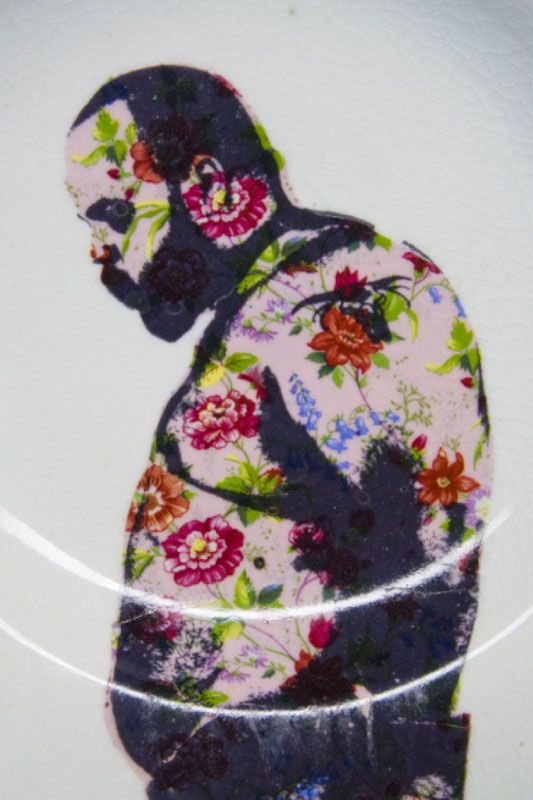If you aren't pretty linked in to the latest happenings in the art world, it's entirely possible that you haven't heard of
Roberto Lugo. If that's the case, I'm here to help remedy that. Lugo is speaking at the
Center for Craft, Creativity and Design on Thursday, May 12 at 6:30. The talk is titled "Ghetto Craft: A Place Where Poverty and Porcelain Intersect," and you're going to want to be there. In front.
Not only is Lugo one of the most talented ceramic artists out there right now, he's also one of the most passionate about issues of
social justice and identity in the arts. His creations are gorgeous, and they're ultimately tied into a passionate, powerful vision that is nothing less than world-changing.
Lugo was already well known in the art world before he gave a speech as an
NCECA Emerging Artist that vaulted him into sensation territory. It is one of the finest and most moving art talks I've ever seen. Do yourself a favor and watch it immediately.
Lugo's belief that pots can change the world has profound force behind it. I spoke with Lugo about his training, his opinions on mixing the traditional with the ground-breaking in his work, and what's on the horizon.
Asheville Grit (AG): How did you choose pottery as your primary medium?
Roberto Lugo (RL): I chose pottery because I took a drawing class in Community College and the professor Jay Spalding was a potter. He asked me to try the potter's wheel and I found myself really addicted from that point.
AG: Your work is so deeply powerful. One reason for this is the way you combine old, traditional styles with imagery that's unexpected. I'm thinking of your
teapots, which are lovely, traditional looking objects combined with imagery from pop culture, symbols of race/culture, etc. Can you talk a little bit about your decision to juxtapose the old and new, the traditional and the more current?

Conveying Tea
, 2012, porcelain, 10” x 8” x 4”
RL: Yes, I want to include and represent my culture and background but not take away from the rich history of ceramics. Specifically, I am working with the form and aesthetic of palaceware, work originally bought and commissioned by royalty. I use this
connection to then paint people who represent where I am from--a indigent Philadelphia community.
AG: What exposure did you have to art growing up, and how did it influence you? How do you think artists can engage/reach younger generations (and/or how are you doing this)?
RL: I didn't take any art classes, but I began doing graffiti art in my teens. I was also inspired by the murals I saw everyday on the way to school. Philadelphia has a rich
mural program and these walls helped me to grow and appreciation of the aesthetics and beauty of what art could bring a community. I am looking for ways to include children like me growing up. I volunteer for the
Claymobile in Philadelphia when I am in town and many of the project that I am working on relate to community service, socially oriented work.
AG: Possibly related: Artists are always (it seems to me!) in a strange position when it comes to success and money. Your work so powerfully engages vastly different groups of people. How do you handle issues around
accessibility? Where can people see your work if they aren't collectors/aren't going to museums? How do you bridge the worlds of upper-crust art aficionados/collectors and people you want to talk to outside of this world?
RL: I found that making work for affordable purposes took away form the craft and value of my work in terms of what I put into it. I believe the content of the work and what it represents has the ability to connect to an audience and owning the objects is not the only experience one could have. The
longevity of my continuing to make work is important because it tells people that they can do what I do and I find this to be part of the experience.

Self Portrait
, 2012, porcelain, 9” round
AG: Can you talk a little bit about current and upcoming projects you're working on?
RL: Currently, I am working to create a pottery workshiop in Puerto Rico, which is in its research stage. I am working on a residency at the clay studio, where I am working on creating an outdoor exhibition to raise funds for the Claymobile program. Lastly, I am going to
Baltimore Clayworks to create planters. These planters will be used to pay homage to individuals who have passed from the lives of the community painting them. These planters will then have plants put in them and this will bring new life from death.
"Ghetto Craft" is part of a series of art talks hosted by the CCCD. For more information, see the Facebook event page
here.